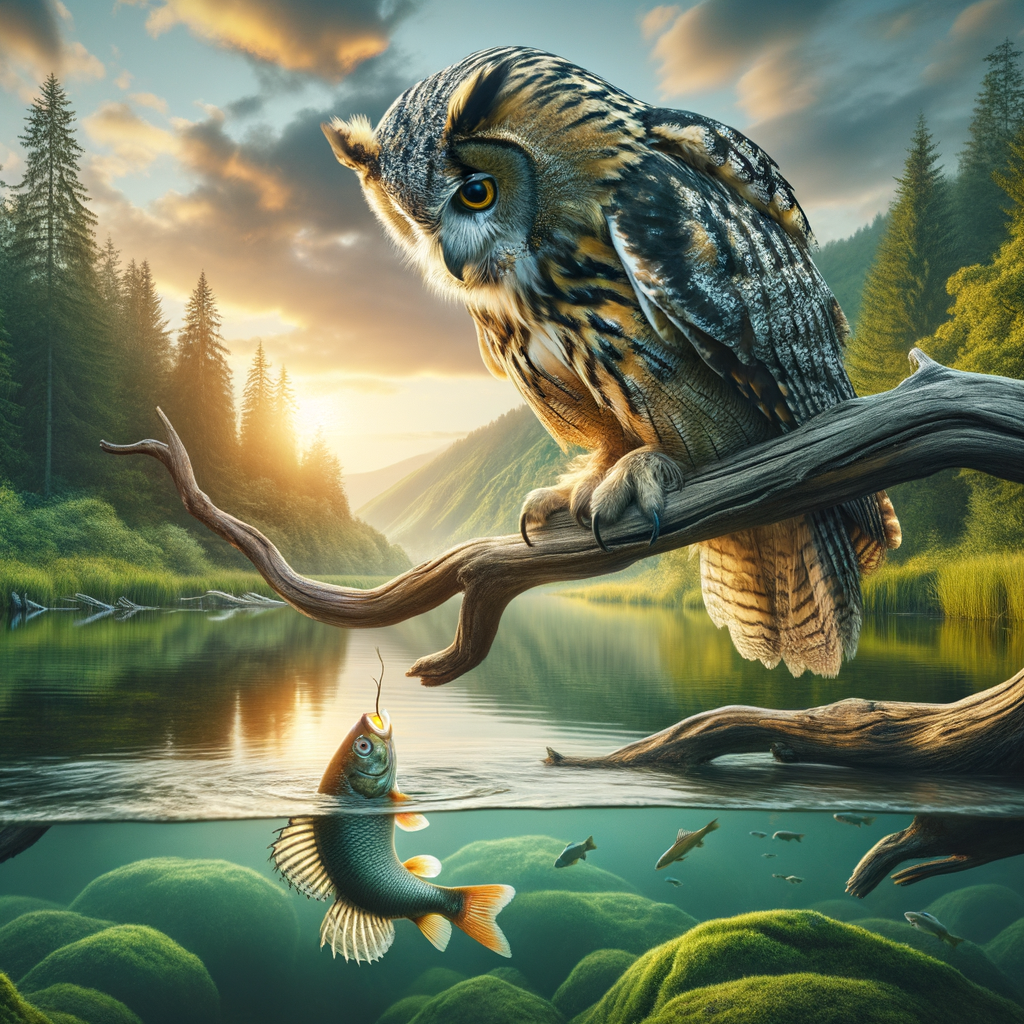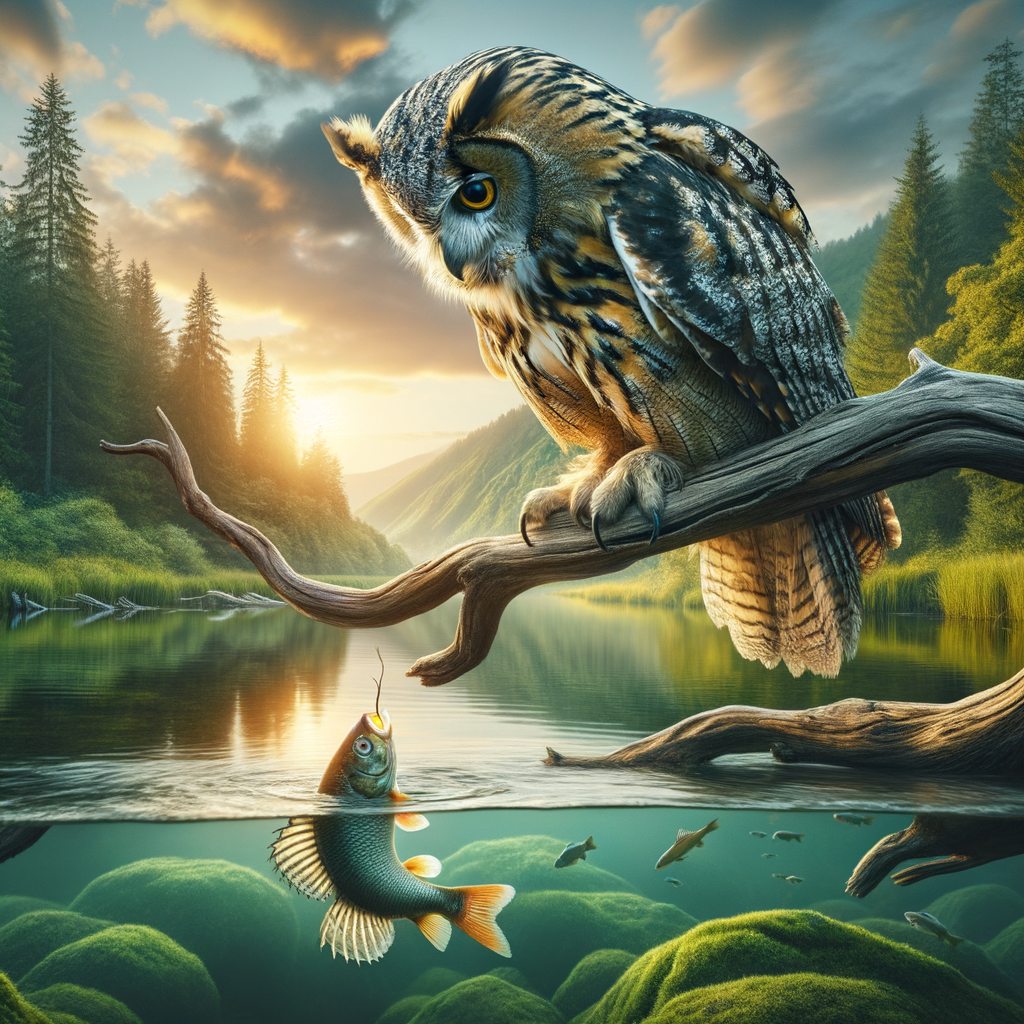
Owls in Aquatic Habitats: An Overview
- Introduction to owls in aquatic environments
Owls are fascinating birds known for their nocturnal habits and silent flight. While many people think of owls living in forests or deserts, some species actually thrive in aquatic habitats. These owls have adapted to living near water, hunting for fish and other aquatic prey.
- Types of owls found in aquatic habitats
Several types of owls are found in aquatic environments. The most well-known is the Blakiston’s Fish Owl. This large owl is native to parts of Russia, China, and Japan. Another example is the Barred Owl, which often lives near rivers and swamps in North America.
- Geographical distribution of aquatic owls
Aquatic owls are found in various parts of the world. Blakiston’s Fish Owl is found in East Asia, particularly in Russia, China, and Japan. The Barred Owl is common in North America, especially in the eastern United States and Canada. These owls prefer habitats with plenty of water sources, such as rivers, lakes, and wetlands.
| Owl Species | Habitat | Geographical Distribution |
|---|---|---|
| Blakiston’s Fish Owl | Rivers, Lakes, Wetlands | Russia, China, Japan |
| Barred Owl | Rivers, Swamps | North America |
Owl Predation on Fish
-
How Owls Hunt in Water Environments
They use their sharp talons to catch fish. Owls often hunt at night when fish are less active. They perch near the water and wait patiently. When they spot a fish, they swoop down quickly and grab it.
-
Impact of Owl Predation on Fish Populations
Owls help control the number of fish in a pond or lake. This keeps the ecosystem balanced. If there are too many fish, they can eat all the plants and insects. Owls help keep fish numbers in check, which is good for the environment.
-
Case Study: Owl Predation in a Specific Aquatic Ecosystem
In a study of the Great Lakes region, scientists found that owls play a key role in the ecosystem. They discovered that owls catch a significant number of fish each year. This helps keep the fish population healthy. The study showed that areas with more owls had better-balanced ecosystems.
Region Number of Owls Fish Population Health Great Lakes High Balanced Small Ponds Low Overpopulated Owls are important for maintaining healthy fish populations. They help control the number of fish, which benefits the entire ecosystem.
Aquatic Ecosystem Predators: The Role of Owls
-
The Food Chain in Aquatic Ecosystems
At the base are plants and algae, which produce food through photosynthesis. Small fish and insects eat these plants. Larger fish, birds, and other animals then eat the smaller fish.
Each level of the food chain is important. If one part is removed, it can affect the whole system. This is why predators like owls play a crucial role in maintaining balance.
-
Owls as Apex Predators in Water Environments
This means they are at the top of the food chain. In aquatic environments, owls hunt for fish, amphibians, and other small animals. Their keen eyesight and silent flight make them excellent hunters.
For example, the Barred Owl often hunts near water. They use their sharp talons to catch fish and other prey.
-
Impact of Owls on Other Aquatic Predators
By hunting fish and small animals, they help control the population of these species. This prevents overpopulation and ensures a healthy ecosystem.
Additionally, owls compete with other predators like herons and raccoons. This competition can influence the behavior and population of these animals.
Owls and Water Environments: A Symbiotic Relationship
Owls and Freshwater Ecosystems
- How owls interact with freshwater environments:
Owls often live near lakes, rivers, and wetlands. These areas provide plenty of food and nesting spots. Owls hunt for fish, frogs, and insects near the water. They use their sharp talons and keen eyesight to catch prey. For example, the Barred Owl is known to hunt along riverbanks and lakeshores. - Impact of owls on freshwater ecosystems:
Owls help control the population of small animals and insects. This keeps the ecosystem balanced. By hunting fish and frogs, they prevent overpopulation, which can harm the water quality. A balanced ecosystem supports healthy plant and animal life. According to a study from Wikipedia, owls play a crucial role in maintaining the health of freshwater habitats (source).
| Owl Species | Freshwater Habitat | Prey |
|---|---|---|
| Barred Owl | Rivers, Lakeshores | Fish, Frogs |
| Great Horned Owl | Wetlands, Marshes | Small Mammals, Insects |
| Eastern Screech Owl | Wooded Streams, Ponds | Insects, Small Fish |
Owls and Marine Ecosystems
- How owls interact with marine environmentsSome owl species live near coastal areas. They hunt small animals that live close to the shore. These owls often hunt at night, using their keen eyesight and hearing.
For example, the Short-eared Owl is often found in coastal marshes. They catch rodents and sometimes small birds. This interaction helps keep the population of these animals in check.
- Impact of owls on marine ecosystemsBy hunting small animals, they help control the population of these species. This balance is crucial for the health of the ecosystem.
For instance, if there are too many rodents, they can harm plants and other animals. Owls help prevent this by keeping the rodent population under control. This makes owls valuable guardians of marine ecosystems.
| Owl Species | Habitat | Prey |
|---|---|---|
| Short-eared Owl | Coastal Marshes | Rodents, Small Birds |
| Snowy Owl | Arctic Coasts | Small Mammals, Fish |
According to Wikipedia, owls are vital for maintaining the balance in various ecosystems, including marine environments. Their presence ensures that prey populations do not grow too large, which helps protect the habitat.
Owl Diet in Aquatic Regions
- Common prey of owls in aquatic habitats: Owls living near water often hunt for fish, frogs, and small aquatic mammals. They also eat insects and crustaceans. For example, the Barred Owl is known to catch crayfish and small fish in shallow waters.
- How the owl’s diet affects the aquatic ecosystem: Owls play a crucial role in maintaining the balance of aquatic ecosystems. By preying on fish and other small animals, they help control the population of these species. This balance is essential for the health of the water environment. For instance, if there are too many fish, they might eat too many insects, which could lead to an overgrowth of algae.
- Adaptations of owls for hunting in water environments: Owls have special adaptations that help them hunt in aquatic regions. Their sharp talons and strong beaks allow them to catch slippery fish. Some owls, like the Snowy Owl, have feathers that help them stay dry while hunting near water. Their excellent night vision and silent flight also make them effective hunters in these environments.
| Adaptation | Purpose |
|---|---|
| Sharp Talons | To catch and hold slippery prey |
| Strong Beak | To tear apart food |
| Feathers | To stay dry while hunting |
| Night Vision | To see in low light conditions |
| Silent Flight | To sneak up on prey |
Owl Interactions with Aquatic Animals
-
How Owls Interact with Other Aquatic Animals
They hunt fish, frogs, and even small water birds. Owls use their sharp talons and keen eyesight to catch these animals, usually at night.
For example, the Barred Owl is known to hunt near water bodies. They sit quietly on branches, watching for movement in the water below.
-
Impact of These Interactions on the Ecosystem
By hunting aquatic animals, they help control the population of these species. This balance is crucial for a healthy environment.
When owls hunt fish, they prevent overpopulation, which can lead to a healthier water ecosystem. Similarly, by hunting frogs and small water birds, they keep these populations in check.
-
Case Study: Owl Interactions in a Specific Aquatic Ecosystem
In the wetlands of Florida, owls like the Great Horned Owl have a significant impact. These owls hunt fish, frogs, and even small alligators!
Researchers have observed that in areas with a healthy owl population, the number of small aquatic animals is balanced. This balance helps maintain the overall health of the wetland ecosystem.
Animal Role in Ecosystem Fish Provide food for owls, help control insect populations Frogs Control insect populations, serve as prey for owls Small Water Birds Part of the food chain, prey for owls
Conclusion: Owls as Guardians of Aquatic Ecosystems
- Summary of the role of owls in aquatic ecosystems: Owls play a vital role in maintaining the balance of aquatic ecosystems. By preying on fish and other small animals, they help control populations and ensure a healthy environment. Their presence indicates a thriving ecosystem.
- Importance of conservation efforts for owls: Protecting owls is crucial for the health of aquatic habitats. Conservation efforts help maintain biodiversity and the natural balance. Without owls, the ecosystem could suffer, leading to overpopulation of certain species and depletion of others.
- Future research directions on owls and aquatic ecosystems: More studies are needed to understand the full impact of owls on aquatic ecosystems. Future research could explore how changes in water quality and climate affect owl populations and their prey. This knowledge can guide conservation strategies and ensure the protection of these important birds.
| Key Insights | Details |
|---|---|
| Role of Owls | Control fish and small animal populations, indicating a healthy ecosystem. |
| Conservation Importance | Maintains biodiversity and natural balance in aquatic habitats. |
| Future Research | Explores impact of water quality and climate on owls and their prey. |
Owls are more than just fascinating birds. They are key players in aquatic ecosystems. Protecting them helps keep our water environments healthy and balanced. Continued research and conservation efforts are essential to ensure these guardians of aquatic ecosystems thrive for generations to come.






